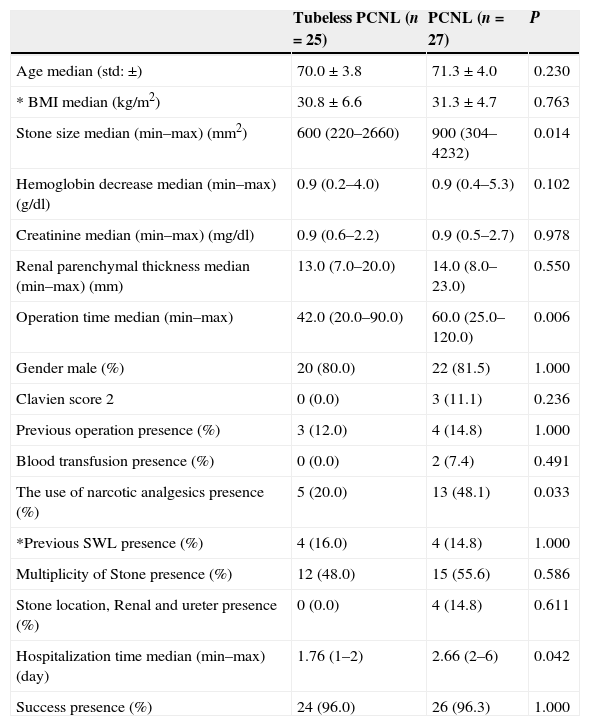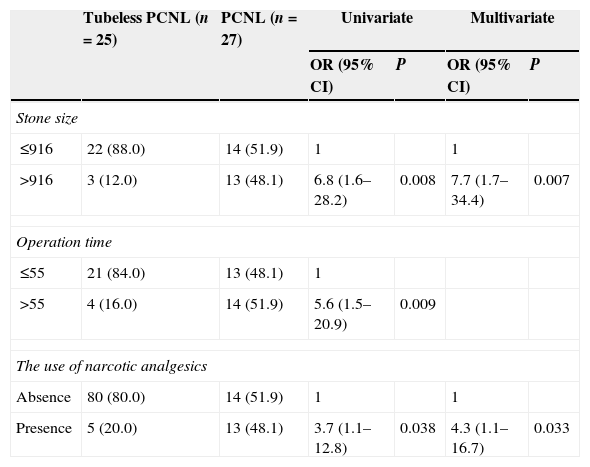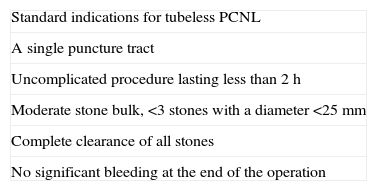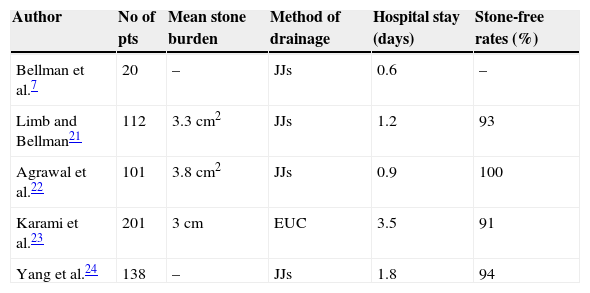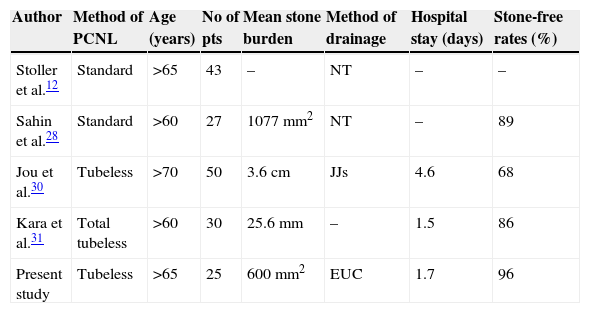Percutaneous nephrolithotomy (PCNL) is a standard, safe, and efficient method for large-volume renal calculi for all age groups. Nephrostomy tube constitutes an invaluable part of the nephrolithotomy operation. However, the nephrostomy tube has been recently replaced with ureteral catheter or double J-stent thanks to advances in urotechnology and operation equipment. The aim of the current article was to evaluate the safety and reliability of tubeless percutaneous nephrolithotomy in the geriatric population.
MethodsBetween January 2009 and September 2013, a total of 52 patients aged 65 years or elder with renal calculi bigger than 2cm underwent PCNL operation. The first group of 25 patients (48%) with a mean age of 70.0 years (std: ±3.8) underwent tubeless PCNL whereas the second group consisting of 27 (52%) patients with a mean age of 71.3 years (std: ±4.0) underwent standard PCNL. The patients were randomly compared retrospectively in terms of burden of calculus, analgesic requirement, creatinine value, renal parenchymal thickness, body-mass index (BMI), clavien score, length of hospitalization, and being calculus-free.
ResultsThe groups were found to be similar in age, BMI, and gender (P>0.05). Burden of calculus, duration of operation, and rate of narcotic analgesic use were found to be statistically significantly higher in the group of Standard PCNL group than in the Tubeless PCNL group (P<0.05). Length of hospital stay was 1.7 days in the group of tubeless PCNL and 2.6 days in the standard PCNL group (P<0.05). No significant difference was found between the groups in terms of fall in hemoglobin, creatinine, values of parenchymal thickness, and clavien score, preoperative blood transfusion, previous SWL, location of calculi, number of access, and rate of success (P>0.05). Burden of calculus was 900mm2 (304–4232) in the standard PCNL group and 600mm2 (220–2660) in the tubeless PCNL group with the difference being statistically significant (P=0.014). Overall success was achieved in 96.0 and 96.3% of tubeless PCNL and standard PCNL patients after one session of PCNL, respectively.
ConclusionsTubeless percutaneous nephrolithotomy was found to be as safe and effective as standard PCNL in the geriatric population. It is recommended especially in this group of patients because of its advantages such as shorter length of hospitalization, less analgesic requirement, and earlier mobilization.
La nefrolitotomía percutánea (NLPC) es un procedimiento estándar, seguro y eficaz para los cálculos renales de gran tamaño en todos los grupos de edad. La sonda de nefrostomía constituye una parte muy valiosa de la nefrolitotomía. Sin embargo, recientemente se ha modificado la sonda de nefrostomía al ser reemplazada por el catéter ureteral o la sonda doble J, gracias a los avances en urotecnología y en las herramientas quirúrgicas. El objetivo del presente artículo es evaluar la seguridad y la fiabilidad de la nefrolitotomía percutánea sin catéter en la población geriátrica.
MétodosEntre enero de 2009 y septiembre de 2013 un total 52 pacientes de 65 o más años con cálculos renales mayores de 2cm fueron sometidos a NLPC. El primer grupo de 25 pacientes (48%), con una edad media de 70,0 años (des: +3,8) fueron sometidos a NLPC sin catéter, mientras que el segundo grupo formado por 27 (52%) pacientes con una edad media de 71,3 años (des: +4,0) fueron sometidos a NLPC estándar. Se compararon aleatoriamente y de forma retrospectiva los pacientes en términos de carga litiásica, necesidad de antibióticos, valores de creatinina, espesor del parénquima renal, índice de masa corporal (IMC), grado de Clavien, tiempo de hospitalización y estado libre de litiasis.
ResultadosSe apreció que los grupos eran similares en cuanto a edad, IMC y sexo (p>0,05). La carga litiásica, la duración del procedimiento quirúrgico y la tasa de empleo de analgésicos narcóticos fueron significativamente mayores desde el punto de vista estadístico en el grupo de NLPC estándar que en el grupo de NLPC sin catéter (p<0,05). El tiempo de hospitalización fue de 1,7 días en el grupo de NLPC sin catéter y de 2,6 en el de NLPC estándar (p<0,05). No se halló ninguna diferencia significativa entre los grupos en cuanto a una disminución en los niveles de hemoglobina, creatinina, los niveles de espesor del parénquima y el grado de Clavien, transfusiones preoperatorias de sangre, LEC previa, localización del cálculo, número de accesos y la tasa de éxito (p>0,05). La carga litiásica fue de 900mm2 (304-4.232) en el grupo de NLPC estándar y de 600mm2 (220-2.660) en el grupo de NLPC sin catéter, siendo esta diferencia estadísticamente significativa (p=0,014). Se alcanzó éxito global en el 96,0 y 96,3% de los pacientes sometidos a NLPC sin catéter y NLPC estándar, respectivamente, tras una sesión de NLPC.
ConclusionesSe determinó que la nefrolitotomía percutánea sin catéter es tan segura y eficaz como la NLPC estándar en la población geriátrica. Está especialmente recomendada en este grupo de pacientes dadas sus ventajas, como son un período de hospitalización más corto, una menor necesidad de analgésicos y una recuperación de la movilidad más rápida.







